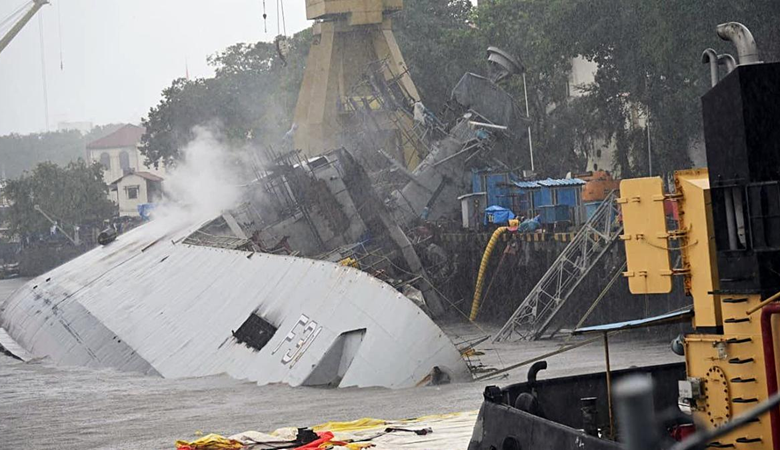INS Brahmaputra Fire Incident Highlights Concerns Over Indian Navy Ship Safety

News Mania Desk/Agnibeena Ghosh/23rd July 2024
The recent incident involving the Indian Navy’s INS Brahmaputra at Mumbai dockyard has thrown a spotlight on the safety and maintenance of naval vessels. The multirole frigate suffered significant damage due to an onboard fire, which led to the vessel losing buoyancy and tilting to its port side. Despite efforts to control the blaze, the ship’s stability has been compromised, highlighting ongoing issues with the maintenance and safety protocols of India’s naval assets.
INS Brahmaputra, a first-of-its-kind guided missile frigate of the ‘Brahmaputra’ class, was commissioned into the Indian Navy in April 2000. This 125-meter-long warship, with a displacement of 5,300 tonnes, is equipped with an array of weaponry, including surface-to-air and surface-to-surface missiles, medium-range guns, and various advanced sensors and anti-submarine rockets. Additionally, it can operate Sea King and Chetak helicopters from its deck. The frigate’s damage underscores a troubling trend in the safety of India’s naval fleet, as it joins a growing list of naval vessels damaged or destroyed by accidents.
The recovery of INS Brahmaputra will be a challenging task, as Mumbai’s dockyard reportedly lacks the capability to upright the vessel. This situation may necessitate the involvement of foreign firms specialized in such operations. The incident has intensified scrutiny of India’s naval maintenance procedures and safety measures.
Former Indian Navy Captain (Retired) Dilip Donde emphasized the importance of having well-established processes and learning from past mistakes to prevent such incidents. The Indian Navy, like other professional armed forces, adheres to stringent protocols during ship operations and repairs. However, the complexity of maintaining stability during a ship’s refit presents unique challenges. Captain (Retd.) Sarabjeet Singh Parmar, who has overseen ships undergoing repairs, explained that maintaining a ship’s balance during such periods is delicate work. When parts are removed or added during a refit, the ship’s weight distribution can shift, potentially leading to instability.
The fire on INS Brahmaputra could have been triggered by a short circuit or sparks from welding activities, as fuel and ammunition are typically removed during refits. The exact cause of the fire is under investigation, and an inquiry has been launched by the Indian Navy to determine the underlying issues. Captain Parmar highlighted the importance of adhering to safety protocols, such as having firefighters present during welding operations, to mitigate risks during repairs.
This incident is the third such case involving damage to an Indian Navy ship at Mumbai’s dockyard, leading to increased criticism of the Western Naval Command’s oversight. While it is crucial to address the shortcomings in the repair procedures, Captain Parmar advised against placing undue blame on the entire dockyard prematurely. The focus should be on thoroughly examining and revising the existing protocols to prevent future occurrences.
As the investigation into the INS Brahmaputra fire progresses, it will be essential for the Indian Navy to reassess and enhance its maintenance and safety procedures to safeguard its fleet and ensure operational readiness.






